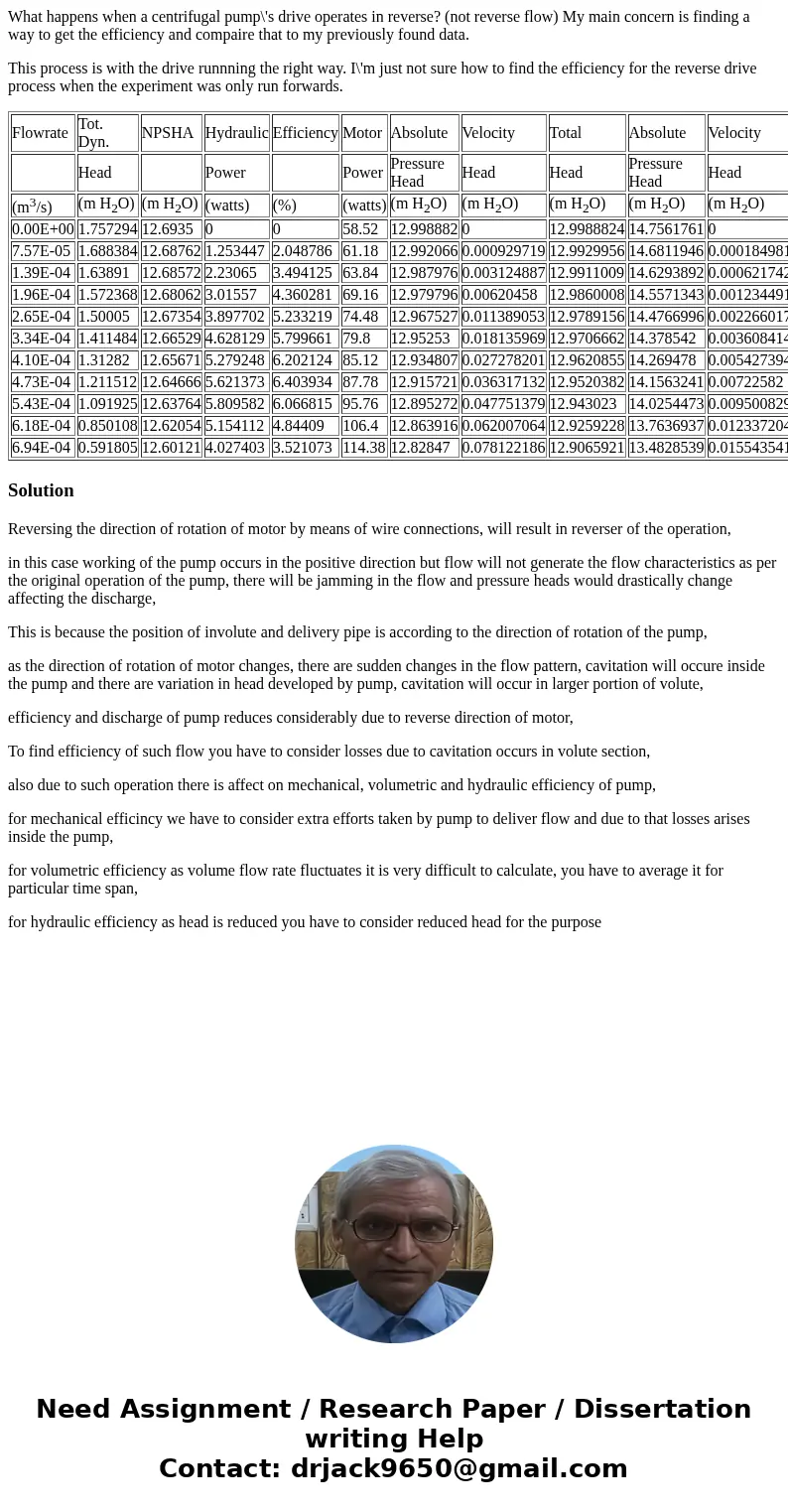What happens when a centrifugal pumps drive operates in reve
What happens when a centrifugal pump\'s drive operates in reverse? (not reverse flow) My main concern is finding a way to get the efficiency and compaire that to my previously found data.
This process is with the drive runnning the right way. I\'m just not sure how to find the efficiency for the reverse drive process when the experiment was only run forwards.
| Flowrate | Tot. Dyn. | NPSHA | Hydraulic | Efficiency | Motor | Absolute | Velocity | Total | Absolute | Velocity | Total |
| Head | Power | Power | Pressure Head | Head | Head | Pressure Head | Head | Head | |||
| (m3/s) | (m H2O) | (m H2O) | (watts) | (%) | (watts) | (m H2O) | (m H2O) | (m H2O) | (m H2O) | (m H2O) | (m H2O) |
| 0.00E+00 | 1.757294 | 12.6935 | 0 | 0 | 58.52 | 12.998882 | 0 | 12.9988824 | 14.7561761 | 0 | 14.7561761 |
| 7.57E-05 | 1.688384 | 12.68762 | 1.253447 | 2.048786 | 61.18 | 12.992066 | 0.000929719 | 12.9929956 | 14.6811946 | 0.000184981 | 14.68137958 |
| 1.39E-04 | 1.63891 | 12.68572 | 2.23065 | 3.494125 | 63.84 | 12.987976 | 0.003124887 | 12.9911009 | 14.6293892 | 0.000621742 | 14.63001094 |
| 1.96E-04 | 1.572368 | 12.68062 | 3.01557 | 4.360281 | 69.16 | 12.979796 | 0.00620458 | 12.9860008 | 14.5571343 | 0.001234491 | 14.55836879 |
| 2.65E-04 | 1.50005 | 12.67354 | 3.897702 | 5.233219 | 74.48 | 12.967527 | 0.011389053 | 12.9789156 | 14.4766996 | 0.002266017 | 14.47896562 |
| 3.34E-04 | 1.411484 | 12.66529 | 4.628129 | 5.799661 | 79.8 | 12.95253 | 0.018135969 | 12.9706662 | 14.378542 | 0.003608414 | 14.38215041 |
| 4.10E-04 | 1.31282 | 12.65671 | 5.279248 | 6.202124 | 85.12 | 12.934807 | 0.027278201 | 12.9620855 | 14.269478 | 0.005427394 | 14.27490539 |
| 4.73E-04 | 1.211512 | 12.64666 | 5.621373 | 6.403934 | 87.78 | 12.915721 | 0.036317132 | 12.9520382 | 14.1563241 | 0.00722582 | 14.16354992 |
| 5.43E-04 | 1.091925 | 12.63764 | 5.809582 | 6.066815 | 95.76 | 12.895272 | 0.047751379 | 12.943023 | 14.0254473 | 0.009500829 | 14.03494813 |
| 6.18E-04 | 0.850108 | 12.62054 | 5.154112 | 4.84409 | 106.4 | 12.863916 | 0.062007064 | 12.9259228 | 13.7636937 | 0.012337204 | 13.7760309 |
| 6.94E-04 | 0.591805 | 12.60121 | 4.027403 | 3.521073 | 114.38 | 12.82847 | 0.078122186 | 12.9065921 | 13.4828539 | 0.015543541 | 13.49839744 |
Solution
Reversing the direction of rotation of motor by means of wire connections, will result in reverser of the operation,
in this case working of the pump occurs in the positive direction but flow will not generate the flow characteristics as per the original operation of the pump, there will be jamming in the flow and pressure heads would drastically change affecting the discharge,
This is because the position of involute and delivery pipe is according to the direction of rotation of the pump,
as the direction of rotation of motor changes, there are sudden changes in the flow pattern, cavitation will occure inside the pump and there are variation in head developed by pump, cavitation will occur in larger portion of volute,
efficiency and discharge of pump reduces considerably due to reverse direction of motor,
To find efficiency of such flow you have to consider losses due to cavitation occurs in volute section,
also due to such operation there is affect on mechanical, volumetric and hydraulic efficiency of pump,
for mechanical efficincy we have to consider extra efforts taken by pump to deliver flow and due to that losses arises inside the pump,
for volumetric efficiency as volume flow rate fluctuates it is very difficult to calculate, you have to average it for particular time span,
for hydraulic efficiency as head is reduced you have to consider reduced head for the purpose

 Homework Sourse
Homework Sourse